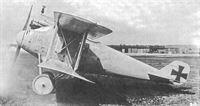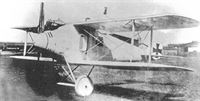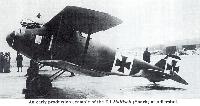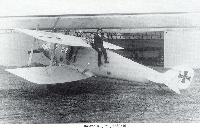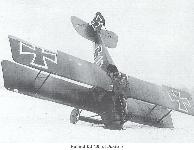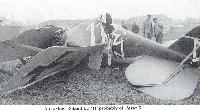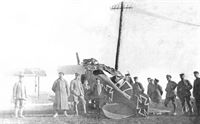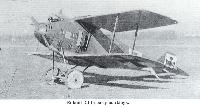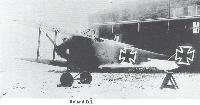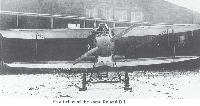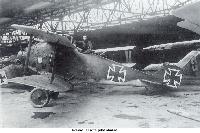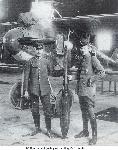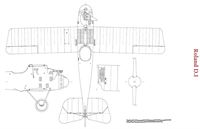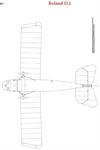
Описание
Страна: Германия
Год: 1916
Истребитель
Варианты
- LFG Roland - D.I - 1916 - Германия
- LFG Roland - D.II - 1916 - Германия
- LFG Roland - D.III - 1917 - Германия
- В.Кондратьев Самолеты первой мировой войны
- O.Thetford, P.Gray German Aircraft of the First World War (Putnam)
- W.Green, G.Swanborough The Complete Book of Fighters
- J.Herris Roland Aircraft of WWI (A Centennial Perspective on Great War Airplanes 9)
- J.Herris Pfalz Aircraft of WWI (A Centennial Perspective on Great War Airplanes 5)
-
J.Herris - Roland Aircraft of WWI /Centennial Perspective/ (9)
Roland D.l of Jasta 5
-
J.Herris - Roland Aircraft of WWI /Centennial Perspective/ (9)
The LFG Roland D.I prototype was the first Roland fighter design and direct ancestor for all early Roland fighters. Clearly derived from the Roland C.II, it used the same engine and technology that made the C.II so successful and shared the strengths and weaknesses of the C.II. The upper wing was built directly into the fuselage without benefit of cabane struts, limiting the pilot's view forward. This feature required two re-designs to provide adequate forward view. Unfortunately, the mediocre maneuverability and handling qualities the D.I inherited from the C.II were a more severe limitation for a single-seat fighter than a two-seater and were not overcome until Roland developed the Roland D.VI.
The LFG Roland D.I shown here was also built under license by Pfalz as the Pfalz D.I. -
Сайт - Pilots-and-planes /WWW/
The second prototype of the Roland D.I in front of the Roland factory at Adlershof.
-
Сайт - Pilots-and-planes /WWW/
The second Roland D.I prototype
Developed from the earlier Roland C.II two-seater, the Roland D.I fighter had two guns and the 160 hp Mercedes D.III engine. It was fast but the pilots' forward view was poor, and the design was quickly revised as the Roland D.II to fix that limitation, particularly problematic for a fighter. -
J.Herris - Roland Aircraft of WWI /Centennial Perspective/ (9)
Prototype Roland D.I 112/16 at the factory. The photo has been re-touched to outline the shape of the vertical tail surfaces which did not contrast much with the sky. The upper wing was built directly into the fuselage without benefit of cabane struts, limiting the pilot's view forward and downward. Unlike the Roland C.II, I-type interplane struts were not used. It was the first of three prototypes ordered in April 1916, the other two were built as Roland D.II fighters.
-
M.Dusing - German & Austro-Hungarian Aero Engines of WWI. Vol.2 /Centennial Perspective/ (65)
The Roland D.I was also powered by the 160 hp Mercedes D III. It was built in small numbers; although fast it had poor handling qualities.
The production LFG Roland D.I shown here at Adlershof was also built under license by Pfalz as the Pfalz D.I. The crosses are of normal proportions, which indicates this may be a Pfalz-built aircraft; Roland-built aircraft had thicker crosses. Production D.I fighters did not have the fuselage side window present in the D.I prototype. -
Сайт - Pilots-and-planes /WWW/
An early production example of the Roland D.I Haifisch (Shark) at Adlershof.
-
Сайт - Pilots-and-planes /WWW/
Test pilot Eugen Wiencziers posing with Roland D.I(Pfal) 1680/16
-
Сайт - Pilots-and-planes /WWW/
Roland D.I(Pfal) 1680/16
-
Сайт - Pilots-and-planes /WWW/
D.I(Pfal) 1680/16
-
Сайт - Pilots-and-planes /WWW/
Roland D.I(Pfal) 1680/16
-
Сайт - Pilots-and-planes /WWW/
Roland D.I attached to Jasta 5 in Winter 1916-1917.
-
Сайт - Pilots-and-planes /WWW/
Roland D.I '10' of Jasta 5
-
Сайт - Pilots-and-planes /WWW/
A crashed Roland D.I '11' probably of Jasta 5
-
J.Herris - Roland Aircraft of WWI /Centennial Perspective/ (9)
This Roland-built D.I in typical factory sprayed camouflage has had an accident. The angular roll-over structure of the D.I resembled that used in later-production C.II aircraft and was not used in later Roland fighters.
-
Сайт - Pilots-and-planes /WWW/
Roland D.I in early markings
-
В.Кондратьев - Самолеты первой мировой войны
"Роланд" D.I с характерной противокапотажной рамой перед кабиной.
Small-scale production of the Roland D I was achieved during the course of 1916. -
Сайт - Pilots-and-planes /WWW/
Roland D.I
-
Сайт - Pilots-and-planes /WWW/
Front view of the same Roland D.I
-
Сайт - Pilots-and-planes /WWW/
Roland D.I with pilot aboard.
-
Сайт - Pilots-and-planes /WWW/
FEA 9 personnel posing with a 50kg PuW bomb.
-
J.Herris - Roland Aircraft of WWI /Centennial Perspective/ (9)
Roland D.I and late (large fin) C.IIa airframes being built on November 8, 1916 in the Kaiserdamm factory.
Другие самолёты на фотографии: LFG Roland C.II - Германия - 1915
-
M.Dusing - German Aviation Industry in WWI. Volume 1 /Centennial Perspective/ (84)
Two Rol D.I and C.IIa in the production hall in Charlottenburg (former airship hangar).
Другие самолёты на фотографии: LFG Roland C.II - Германия - 1915
В.Кондратьев Самолеты первой мировой войны
"РОЛАНД " D.I / ROLAND D.I
"Роланд" D.I был создан летом 1916 года на фирме "Люфтфарцойг Гезельшафт" (LFG), выпускавшей самолеты под торговой маркой "Роланд". Машина разработана под руководством инженеров Танцена и Хоффмана на базе весьма удачного двухместного многоцелевого аэроплана " Роланд" C.II.
При переделке в истребитель самолет был значительно уменьшен в размерах, а оригинальные I-образные стойки крыла заменены на обычные. Неизменной осталась конструкция фюзеляжа, являвшаяся отличительной чертой самолетов фирмы LFG. Продольные половины фюзеляжа выклеивались на болванках из нескольких слоев тонкого соснового шпона, а затем соединялись по осевой линии. В результате получалась легкая, прочная и жесткая "скорлупа" очень чистых аэродинамических форм.
Еще одной отличительной особенностью "Роланда" было то, что его верхнее крыло крепилось без центральных стоек непосредственно к фюзеляжу. Это обеспечивало пилоту прекрасный обзор вверх, лучший, чем у любых других бипланов, но обзор вниз был явно недостаточен, что особенно опасно на рулении и при посадке. К тому же, в случае капотирования машины летчик подвергался повышенному риску. Из-за этого перед кабиной пришлось установить стальную противокапотажную раму.
В качестве силовой установки использовался стандартный для тогдашних немецких истребителей мотор "Мерседес" D.III мощностью 160 л.с. Вооружение - один синхронный пулемет LMG 08/15.
Первый полет прототипа состоялся в июле 1916 г. Самолет начал строиться серийно, но после выпуска 60 экземпляров, авиасборочный завод LFG в Адлерсхофе сгорел при пожаре.
ЛЕТНО-ТЕХНИЧЕСКИЕ ХАРАКТЕРИСТИКИ
Размах, м 8,94
Длина, м 6,93
Площадь крыла, кв.м 22,80
Сухой вес, кг 699
Взлетный вес, кг 932
Скорость максимальная, км/ч 175
Время подъема на высоту
2000 м, мин. 6,5
Потолок, м 5000
Описание:


